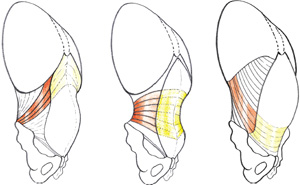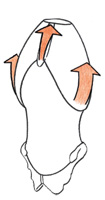A “USER’S GUIDE” TO A FLAT BELLY
 Alternately Stretch and Contract the Abdominals
Alternately Stretch and Contract the Abdominals
 Alternately Contract the Broad Muscles
Alternately Contract the Broad Muscles
 Alternately Contract the Broad Muscles and Rectus Abdominis
Alternately Contract the Broad Muscles and Rectus Abdominis
Alternately Stretch and Contract the Abdominals
When we alternate the stretching and contraction of a muscle, the contractile fibers of the muscle change in shape and volume, and this movement of the tissue promotes blood circulation to the core of the muscle.
The recommended exercises in part 4 of this book often alternate stretching and contraction of the abdominal muscles. In a contraction, the contractile (red) fibers of the muscle shorten and thicken, while the white noncontractile fibers (tendon or aponeurosis) are put under tension. In a stretch, both the contractile and noncontractile tissues are put under tension.

Stretching the internal obliques

Contracting the internal obliques
Alternately Contract the Broad Muscles
The broad muscles, in a three-layer latticework, adhere a bit to each other by way of their fascia “envelopes.”

The broad muscles form a three-layer latticework.
When one of the obliques contracts preferentially in an exercise, it draws the other two layers of muscle along with it, in the direction of its contraction. This changes the form of the other two muscles, whose fibers don’t run in the same direction. They are “massaged” a little, like a towel being twisted. If on the next contraction we focus on another oblique, the same phenomenon occurs, and all three layers move in another direction.
When we alternate the contractions of the broad muscles (obliques and transversus abdominis) in this way, the sliding/massaging that it causes stimulates circulation, which nourishes the tissues.
The suggested exercises at the end of this book often alternate the contraction of the broad muscles.
Alternately Contract the Broad Muscles and Rectus Abdominis
The broad muscles pull the anterior aponeurosis to the sides, putting it under lateral tension.
The rectus abdominis, when contracted, shortens from top to bottom along the length of the belly. It pulls the anterior aponeurosis upward and downward, in the same direction as its fibers.

Alternating the direction of traction in this way promotes mobility and good elimination in the tissues that are being stretched.

Coordinate Abdominal Contractions
Each of the abdominals can contract in its entirety or only in part because these muscles are innervated by different groups of nerves.
We can contract the abdominals in stages at precise levels. For example, we can pull in just the upper belly, the mid-belly, or the lower belly. It’s good to try this just to note that it is indeed possible and even easy.

We can pull in just the upper belly, the mid-belly, or the lower belly.
We can also combine contractions to pull the belly in successive stages in one direction. This will push the abdominal mass in a given direction, a little like pushing toothpaste in a tube from one end to the other. Certain contraction combinations are more interesting than others.
If we start pulling the belly in at the top and work downward, we push the belly toward the pelvis. But if we start the contraction from the bottom and work upward, this pushes the belly up. If we’re looking for a flat belly, the best way to work is with this type of “ascending contraction.”
Coordinate Abdominal Work with the Breath
A detailed study of the various ways in which we can coordinate abdominal work and the breath are not within the scope of this work. Basically, what we will look at here are two principal types of inhalation and exhalation.
An inhalation may be diaphragmatic, which will cause the belly to expand, or costal (with the ribs), which tends to pull the belly in.

A diaphragmatic inhalation
When we are doing abdominal work on an inhalation, it’s best to choose costal breathing. This is what we propose in the exercises at the end of this book.

A costal inhalation
An exhalation can be costal, which lowers the ribs and can push out the belly, or abdominal, which brings the abdomen up toward the thorax and can cause the belly to pull in.

A costal exhalation
When we practice abdominal exercises on an exhalation, it’s best to choose an abdominal exhalation. This is what we propose in the exercises in this book.

An abdominal exhalation
However, abdominal work often naturally imposes its own breathing pattern: it generally closes the ribs, and so we tend to associate abs work with a costal exhalation. The reverse is not spontaneous and therefore takes a bit of practice.
If you contract the abdominals on an exhalation, it’s important that the exhalation be accompanied by a lifting of the abdomen and not by a closing of the ribs.
In general, when we do an abdominal exercise, “visceral synchronization” most often follows the dominant pattern of “skeletal synchronization.” For example, when doing a crunch, we roll the spine from top to bottom, and we tend to contract the abdominals in the same direction, from high to low. This is not desirable for the perineum or for the walls of the abdomen. It would be better, when the movement moves from top to bottom, to coordinate this with an “ascending contraction.” However, this is difficult because the movements run counter to each other.

A crunch tends to contract the abdominals from top to bottom.